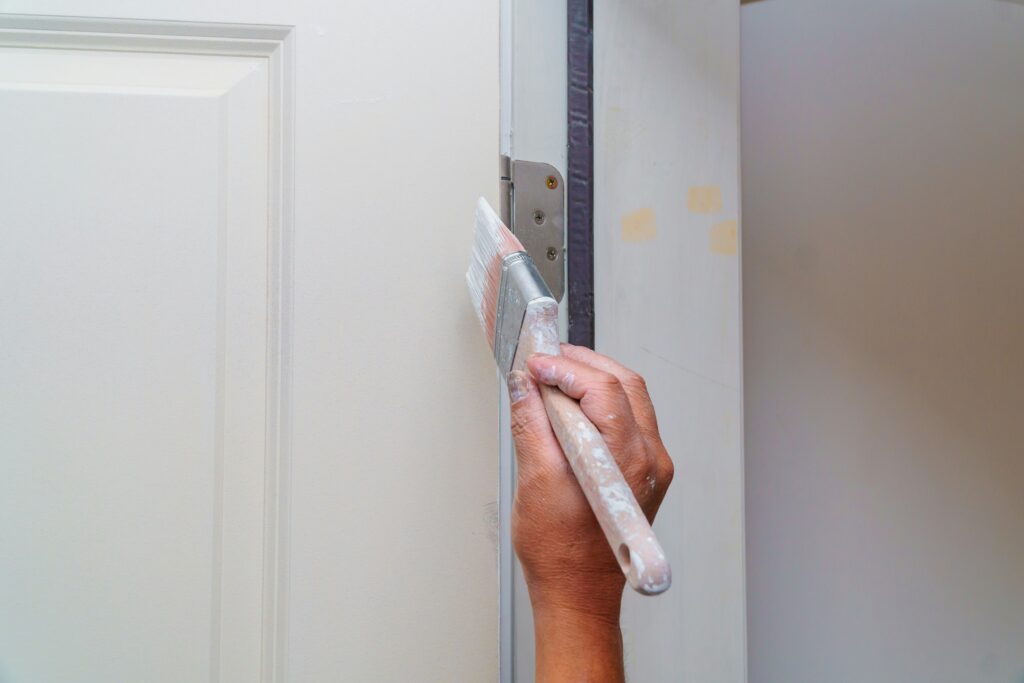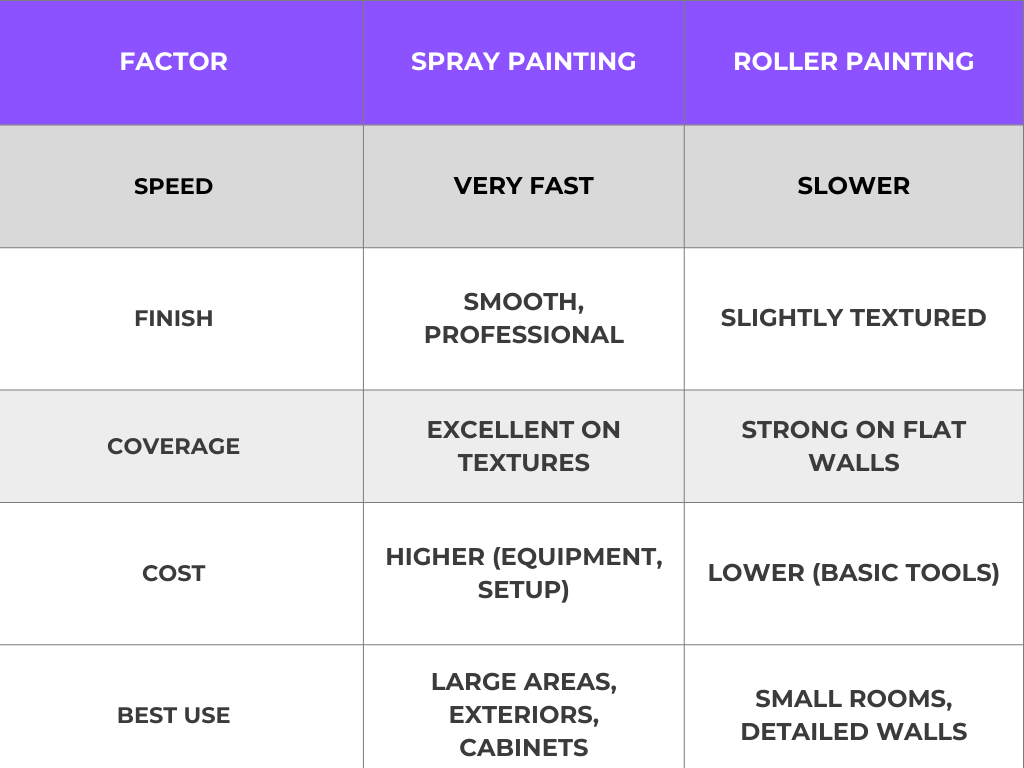Table of Contents
Introduction
When refreshing your home or business with a new coat of paint, one of the first questions to ask is: Which method should I use—spraying or rolling? While colour choice often gets the most attention, the way paint is applied can dramatically affect the final look, durability, and even the overall cost of the project.
The debate of Spray vs Roller Painting is not new. Professional painters know that each method has advantages and limitations. Spraying can deliver flawless finishes on large surfaces, while rolling offers control and consistency in detailed areas. Choosing the right method means understanding your space, budget, and desired outcome.
In this guide, we’ll break down paint application methods, explore spray painting benefits, consider the roller painting pros and cons, and share expert advice on choosing painting technique for different surfaces.
👉 Want a professional finish every time? Visit our Residential Painters Brisbane page for expert services you can trust.
Understanding Spray vs Roller Painting
Before deciding, it’s important to grasp what makes these techniques different.
Spray Painting
Spray painting uses a spray gun powered by air or airless systems to distribute fine particles of paint evenly across surfaces. It’s quick, efficient, and creates a smooth, uniform finish.
Roller Painting
Roller painting uses a paint roller—typically covered in fabric—to apply paint directly to the wall. It’s slower but allows precision and control, especially in smaller rooms.
The choice between Spray vs Roller Painting often comes down to surface type, project size, and finish preferences.
Spray Painting Benefits
Spraying has become popular among both homeowners and professional painters because of its efficiency.
Advantages of Spray Painting
Speed: Large areas can be painted much faster than with rollers.
Smooth Finish: Ideal for walls, ceilings, and cabinetry where brush or roller marks are undesirable.
Better Coverage: Paint reaches corners, crevices, and textured surfaces with ease.
Professional Look: Perfect for high-end finishes in modern spaces.
When to Choose Spray Painting
Large open-plan living areas.
Exteriors with brick or weatherboard textures.
Furniture, cabinets, and doors requiring a flawless look.
These spray painting benefits explain why it’s often chosen for modern homes and commercial properties.

Roller Painting Pros and Cons
Rolling paint is the traditional approach, and it’s still widely used for good reason.
Pros
Control: Less overspray and more precise coverage.
Cost-effective: Requires minimal equipment.
Thicker Coats: Paint is applied more heavily, which can increase durability.
Best for Interiors: Great for rooms where furniture and fixtures limit movement.
Cons
Slower Application: Takes more time than spraying.
Potential Roller Marks: Especially if not applied carefully.
Challenging for Textured Surfaces: Doesn’t penetrate cracks or grooves as well as spraying.
When evaluating roller painting pros and cons, the choice often comes down to patience and surface detail.
Choosing Painting Technique for Different Rooms
Every space has unique requirements. Here’s how to decide between Spray vs Roller Painting in specific rooms:
Living Rooms and Bedrooms
Best method: Roller painting for smooth, consistent walls.
Reason: Greater control and less mess around furniture.
Kitchens and Bathrooms
Best method: Combination. Use spray painting for cabinets and roller for walls.
Reason: Spraying delivers sleek finishes, rolling ensures thicker coats where moisture is present.
Exteriors
Best method: Spray painting for speed and coverage.
Reason: Handles textured brick, timber, and large surfaces efficiently.
Offices and Commercial Spaces
Best method: Depends on design. Rollers for enclosed offices, spray systems for large open spaces.
When choosing painting technique, think about room size, texture, and whether speed or control matters most.
Best Painting Method for Walls
Walls make up the bulk of most painting projects, so deciding the best painting method for walls is crucial.
Smooth walls: Rollers are reliable and deliver solid coverage.
Textured walls: Sprayers reach grooves and prevent patchy finishes.
Feature walls: Rollers allow careful control of patterns or bold colours.
Ultimately, a hybrid approach is often best—rollers for main surfaces and sprayers for trims or accents.
Paint Application Methods: A Side-by-Side Comparison

This comparison highlights the strengths and trade-offs of paint application methods.
Mistakes to Avoid in Spray vs Roller Painting
Skipping Prep: Surfaces must be clean, sanded, and primed.
Poor Masking: Spray painting requires careful masking to avoid overspray.
Cheap Equipment: Low-quality sprayers or rollers can ruin the finish.
Using Wrong Paint: Not all paints are designed for both methods.
Avoiding these pitfalls ensures a polished result with either method.
Professional Insights on Spray vs Roller Painting
Painters often use both methods in the same project. For example:
Spray painting exteriors for speed.
Rolling interiors for control.
Spraying cabinets while rolling trims.
👉 Learn more about our professional approach at Residential Painters Brisbane.
By combining techniques, professional painters deliver results tailored to each space, balancing efficiency with quality.
Long-Term Results: Durability and Maintenance
Which lasts longer—Spray vs Roller Painting?
Spray: Provides a thinner coat but smooth, even coverage. Works well with primers and finishes.
Roller: Applies a thicker coat, often more durable in high-traffic areas.
Both methods can last years if paired with quality paint and proper maintenance.
Conclusion
The debate of Spray vs Roller Painting doesn’t have a one-size-fits-all answer. Spray painting shines for speed and smooth finishes, while rolling provides control and durability. The best results often come from combining both methods strategically.
By understanding paint application methods, weighing spray painting benefits, and considering roller painting pros and cons, you can make informed decisions. Whether it’s the best painting method for walls in your home or a large commercial project, matching the technique to the space is key.
Ready to transform your property? Visit our homepage, explore Residential Painters Brisbane, or Contact Us today to discuss your project with professionals.
FAQs
Q1: Is spray painting better than roller painting?
Not always. The choice between Spray vs Roller Painting depends on the type of project you’re working on. Spray painting is ideal when you need speed and a perfectly smooth finish, such as on exterior walls, ceilings, or cabinetry. It’s also more effective on textured surfaces, where rollers may leave patchy results.
On the other hand, roller painting is better suited to smaller rooms and areas that require precision, like bedrooms, living spaces, or walls near fixtures. Rollers also apply thicker coats, which can make them more durable in high-traffic areas. So, while spray painting has efficiency and coverage on its side, rollers remain the go-to choice for detailed work.
Q2: What is the best painting method for walls?
The best painting method for walls depends on the type of surface and the look you want to achieve. For smooth interior walls, rollers are usually the best option because they provide consistent coverage, minimise overspray, and allow painters to work around furniture or edges with ease. They’re also more forgiving for DIY projects where control matters.
For textured or exterior walls, spray painting is often more effective. The fine mist penetrates grooves and uneven surfaces, delivering a uniform finish that rollers can struggle to achieve. Many professional painters recommend spraying large exterior areas and then using rollers to back-roll for durability and even application.
Q3: Can I combine spray and roller techniques?
Yes, and in fact, many professionals prefer a hybrid approach when debating Spray vs Roller Painting. For example, painters might spray large, open surfaces like ceilings or exterior cladding to save time, then switch to rollers for walls, trims, or detailed edges where precision is required.
This method combines the strengths of both techniques: the speed and smoothness of spray painting with the control and durability of rolling. Using both also helps achieve thicker coats, reduce overspray, and ensure every corner is covered. For many projects, combining spray and roller painting provides the most balanced, professional result.






